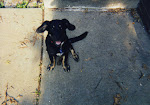A couple of days behind... Will try to add some pix when I get a chance.
Yesterday was our second day in Szeged - a lovely town I'm pretty sure we never went to. I think it was always on the list but at the end our stay it seemed like just one more Hungarian town - we elected for Zagreb instead. Most of Szeged was destroyed in the flood of 1879 (only 250 of 6000 homes survived). The old synagogue which was on somewhat high ground far from the banks of the Tisza had a memorial watermark just above its steps. A half korut encircled the main part of downtown, enclosing a mostly pedestrian friendly area between the river and the road. An exclusive promenade of several blocks donned both chains and boutiques. A sizeable park with many statues capped the walk at one end. Towards the southern end of the downtown was the gigantic church. At its clocktower end was the great square - often compared to San Marcos - covered on three sides by Szeged University buildings.
On the other side of the river, across the Belvarosi Bridge, was both a new and old waterpark as well as a park, campgrounds, and quite suburbs. Beneath the bridge was the legendary Halaszcsarda where we ate the required Fish Stew augmented by an interesting recipe for Stuffed Cabbage.
Other than walking about and a trip to the Pick Salami and Paprika museum, much of our time in Szeged was devoted to continuing research on the Karbiner, Hegel, Morel, Hauser history in Feketic.
Today, we made the long (100 km?) journey to Feketic. Going to Serbia proved untraumatic - we were waved through the checkpoints. One custom official on the Serbian side asked where we going. His response to our answer, "Beautiful town! One road."
We extended our drive a bit further by touring Subotica. Another lovely town with all its fountains under repair. We wandered into an art gallery and were warmly greeted by a woman who spoke excellent English and thought our historical quest was quite a good adventure. Arriving in Feketic, we found our hotel (indeed not difficult as it is truly only one road with a series of swatches) and got a brief history in a mix of German and Hungarian from its owner. He explained there were no more Danauschwabans here but no shortage of tourists who come looking for them. He showed us where the "big cemetery" was on the map and showed us which side to go to for the German graves. He mentioned that it was largely overgrown but his explanation was somewhat lost on us until we saw the state of disrepair of the German side of the cemetery. The beginnings of Tikal is what I told Janine - the ancient city covered by jungle for 500 years and stumbled upon by wandering explorers. Only a few graves of German descent could be found - most had been choked and broken under an almost impenetrable forest of underbrush and small trees. Since Tito had ousted or killed almost all Germans in 1945, no one had remained behind that seemed to care about this side of the graveyard. Explainable but something of a disappointment that the rows of Kellemans, Horvaths, and Deaks did not have their counterparts of Karbiners, Hausers, and Morrells. We did manage to find a first and second war memorial - some of Janine's distant cousins appeared on the role for the Great War but only Hungarian names donned the listed for WWII.
Subscribe to:
Post Comments (Atom)


No comments:
Post a Comment